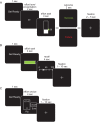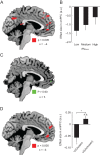Roles of Ventromedial Prefrontal Cortex and Anterior Cingulate in Subjective Valuation of Prospective Effort
- PMID: 30541111
- PMCID: PMC6735256
- DOI: 10.1093/cercor/bhy310
Roles of Ventromedial Prefrontal Cortex and Anterior Cingulate in Subjective Valuation of Prospective Effort
Abstract
The perceived effort level of an action shapes everyday decisions. Despite the importance of these perceptions for decision-making, the behavioral and neural representations of the subjective cost of effort are not well understood. While a number of studies have implicated anterior cingulate cortex (ACC) in decisions about effort/reward trade-offs, none have experimentally isolated effort valuation from reward and choice difficulty, a function that is commonly ascribed to this region. We used functional magnetic resonance imaging to monitor brain activity while human participants engaged in uncertain choices for prospective physical effort. Our task was designed to examine effort-based decision-making in the absence of reward and separated from choice difficulty-allowing us to investigate the brain's role in effort valuation, independent of these other factors. Participants exhibited subjectivity in their decision-making, displaying increased sensitivity to changes in subjective effort as objective effort levels increased. Analysis of blood-oxygenation-level dependent activity revealed that the ventromedial prefrontal cortex (vmPFC) encoded the subjective valuation of prospective effort, and ACC activity was best described by choice difficulty. These results provide insight into the processes responsible for decision-making regarding effort, partly dissociating the roles of vmPFC and ACC in prospective valuation of effort and choice difficulty.
Keywords: anterior cingulate cortex; choice difficulty; effort; fMRI; ventromedial prefrontal cortex.
© The Author(s) 2018. Published by Oxford University Press. All rights reserved. For Permissions, please e-mail: journals.permissions@oup.com.
Figures






Similar articles
-
Neural Signatures of Value Comparison in Human Cingulate Cortex during Decisions Requiring an Effort-Reward Trade-off.J Neurosci. 2016 Sep 28;36(39):10002-15. doi: 10.1523/JNEUROSCI.0292-16.2016. Epub 2016 Sep 28. J Neurosci. 2016. PMID: 27683898 Free PMC article.
-
Dissociating contributions of ACC and vmPFC in reward prediction, outcome, and choice.Neuropsychologia. 2014 Jul;59:112-23. doi: 10.1016/j.neuropsychologia.2014.04.019. Epub 2014 May 9. Neuropsychologia. 2014. PMID: 24813149
-
The Subjective Value of Cognitive Effort is Encoded by a Domain-General Valuation Network.J Neurosci. 2019 May 15;39(20):3934-3947. doi: 10.1523/JNEUROSCI.3071-18.2019. Epub 2019 Mar 8. J Neurosci. 2019. PMID: 30850512 Free PMC article.
-
Neurobiological foundations and clinical relevance of effort-based decision-making.Brain Imaging Behav. 2024 Oct;18(5):1-30. doi: 10.1007/s11682-024-00890-x. Epub 2024 May 31. Brain Imaging Behav. 2024. PMID: 38819540 Review.
-
The neural basis of effort valuation: A meta-analysis of functional magnetic resonance imaging studies.Neurosci Biobehav Rev. 2021 Dec;131:1275-1287. doi: 10.1016/j.neubiorev.2021.10.024. Epub 2021 Oct 25. Neurosci Biobehav Rev. 2021. PMID: 34710515 Review.
Cited by
-
Motor cortical thickness is related to effort-based decision-making in humans.J Neurophysiol. 2020 Jun 1;123(6):2373-2381. doi: 10.1152/jn.00118.2020. Epub 2020 May 6. J Neurophysiol. 2020. PMID: 32374197 Free PMC article.
-
The Neurobiology of Cognitive Fatigue and Its Influence on Effort-Based Choice.J Neurosci. 2025 Jun 11;45(24):e1612242025. doi: 10.1523/JNEUROSCI.1612-24.2025. J Neurosci. 2025. PMID: 40345833
-
Using functional connectivity changes associated with cognitive fatigue to delineate a fatigue network.Sci Rep. 2020 Dec 14;10(1):21927. doi: 10.1038/s41598-020-78768-3. Sci Rep. 2020. PMID: 33318529 Free PMC article. Clinical Trial.
-
Impulse Control Disorders and Effort-Based Decision-Making in Parkinson's Disease Patients with Subthalamic Nucleus Deep Brain Stimulation.Mov Disord Clin Pract. 2025 Apr;12(4):484-496. doi: 10.1002/mdc3.14318. Epub 2025 Jan 3. Mov Disord Clin Pract. 2025. PMID: 39749399 Free PMC article.
-
The Neurobiology of Cognitive Fatigue and Its Influence on Effort-Based Choice.bioRxiv [Preprint]. 2024 Jul 18:2024.07.15.603598. doi: 10.1101/2024.07.15.603598. bioRxiv. 2024. Update in: J Neurosci. 2025 Jun 11;45(24):e1612242025. doi: 10.1523/JNEUROSCI.1612-24.2025. PMID: 39071329 Free PMC article. Updated. Preprint.
References
-
- Abeler J, Falk A, Goette L, Huffman D. 2011. Reference points and effort provision. Am Econ Rev. 101:470–492.
-
- Augenblick N, Niederle M, Sprenger C. 2015. Working over time: dynamic inconsistency in real effort tasks. Q J Econ. 130(3):1067–1115.
Publication types
MeSH terms
Grants and funding
LinkOut - more resources
Full Text Sources

